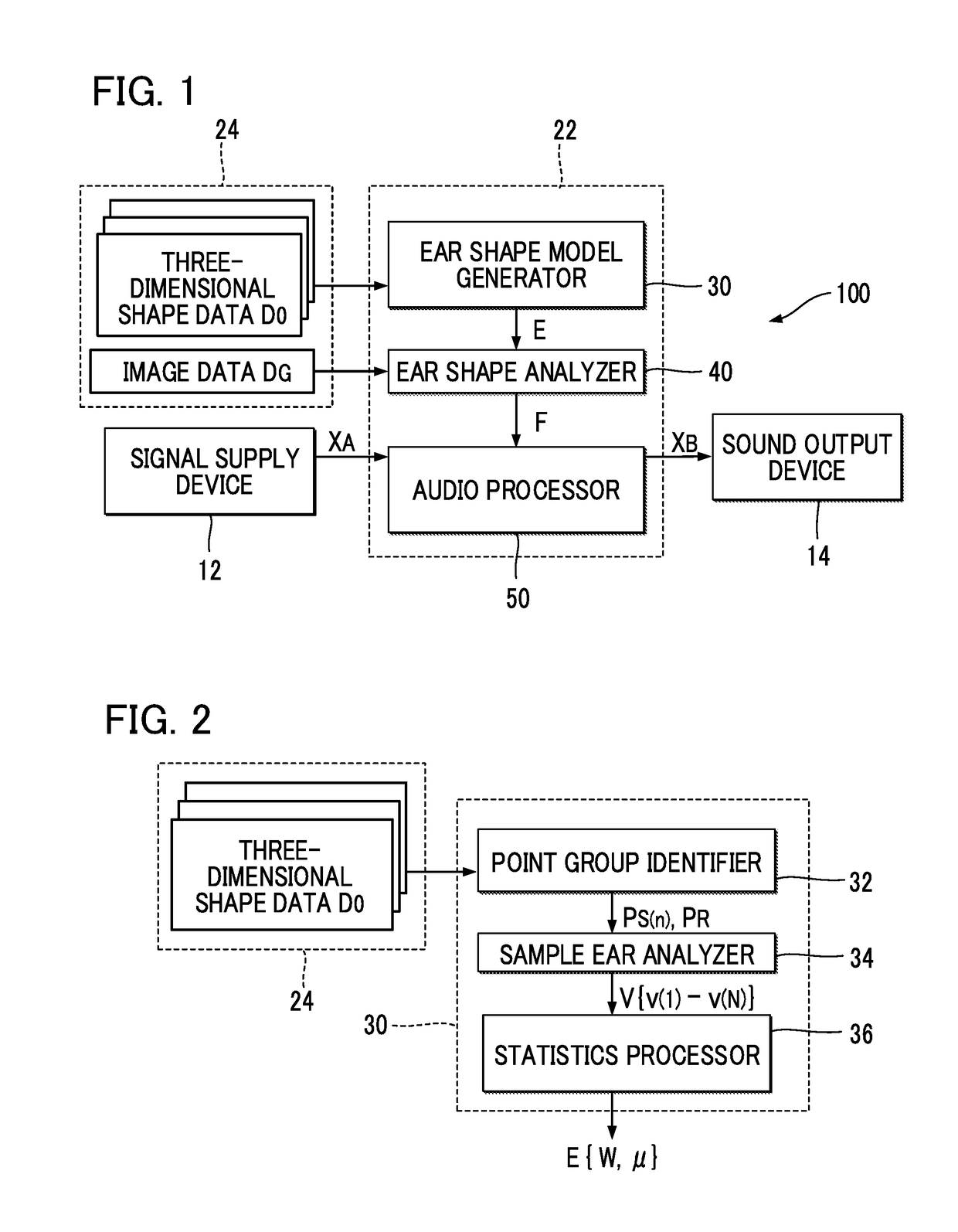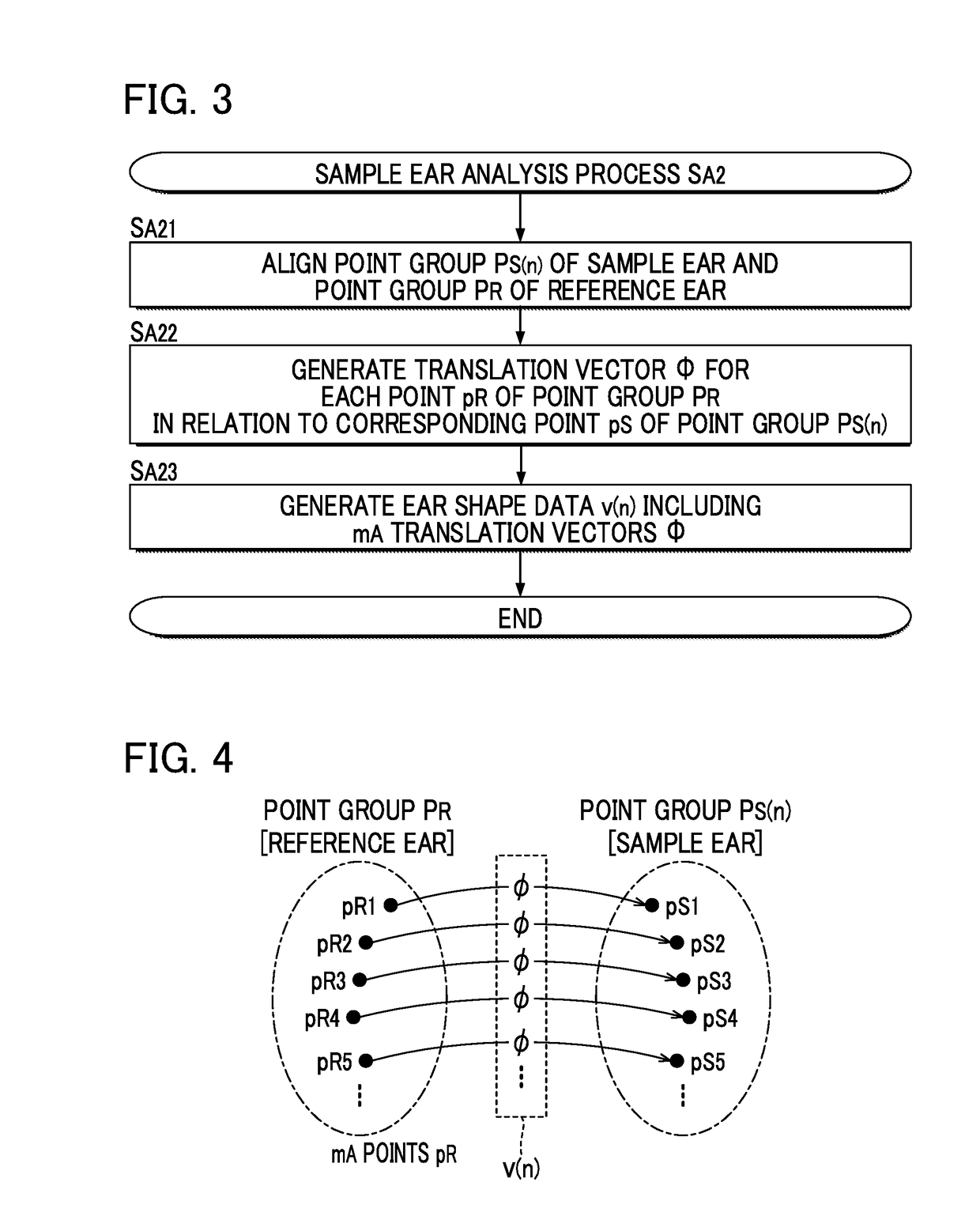Ear Shape Analysis Method, Ear Shape Analysis Device, and Ear Shape Model Generation Method
a technology of ear shape and analysis method, which is applied in the field of analyzing an ear shape, can solve the problems of considerable physical and psychological burdens on the listener, and the listener is unable to perceive the location of a sound image appropriately, and achieve the effect of reducing the probability of misestimating an ear shap
- Summary
- Abstract
- Description
- Claims
- Application Information
AI Technical Summary
Benefits of technology
Problems solved by technology
Method used
Image
Examples
first embodiment
[0032]FIG. 1 is a block diagram showing a configuration of an audio processing device 100 according to a first embodiment of the present invention. As shown in FIG. 1, a signal supply device 12 and a sound output device 14 are connected to the audio processing device 100 of the first embodiment. The signal supply device 12 supplies an audio signal XA representing a sound, such as a voice and a music sound, to the audio processing device 100. Specific examples of the signal supply device 12 include: a sound receiving device that receives a sound in the surroundings to generate an audio signal XA; and a playback device that acquires an audio signal XA from a recording medium (either portable or in-built) and supplies the same to the audio processing device 100.
[0033]The audio processing device 100 is a signal processing device that generates an audio signal XB by applying audio processing to the audio signal XA supplied from the signal supply device 12. The audio signal XB is a stereo...
second embodiment
[0072]A second embodiment of the present invention is described below. In the different embodiments described below, elements having substantially the same actions or functions as those in the first embodiment will be denoted by the same reference symbols as those used in the description of the first embodiment, and detailed description thereof will be omitted as appropriate.
[0073]In the sample ear analysis process SA2 (SA22) in the first embodiment, a translation vector φ is calculated for every point pR of the point group PR of the reference ear, in relation to each corresponding point pS of a sample ear. In the second embodiment, a translation vector φ is calculated for each of mA points pR constituting a part (hereinafter, “first group”) of the point group PR of the reference ear, in relation to each corresponding point pS of a sample ear. In other words, while in the first embodiment the total number of the points pR constituting the point group PR of the reference ear is expre...
third embodiment
[0080]In the first embodiment, the statistics processor 36 generates a transformation matrix W with M rows and M columns. A statistics processor 36 of the third embodiment removes (a) prescribed row(s) from the lower rows of the transformation matrix W with M rows and M columns (that is, (a) prescribed row(s) corresponding to small eigenvalues), the transformation matrix W having been generated by performing principal component analysis on N ear shape data v(1) to v(N), and generates an ear shape model E including a transformation matrix W′ that has been obtained by the removal and has M′ rows and M columns (here, M′36 deletes (M−M′) rows from the (M′+1) th row to the Mth row in the matrix with M rows and M columns generated by the principal component analysis, and thereby obtains the transformation matrix W′ with M′ rows and M columns. Elements of rows from the first row to the M'th row are the same between the transformation matrix W and the transformation matrix W′.
[0081]An ear s...
PUM
 Login to View More
Login to View More Abstract
Description
Claims
Application Information
 Login to View More
Login to View More - R&D
- Intellectual Property
- Life Sciences
- Materials
- Tech Scout
- Unparalleled Data Quality
- Higher Quality Content
- 60% Fewer Hallucinations
Browse by: Latest US Patents, China's latest patents, Technical Efficacy Thesaurus, Application Domain, Technology Topic, Popular Technical Reports.
© 2025 PatSnap. All rights reserved.Legal|Privacy policy|Modern Slavery Act Transparency Statement|Sitemap|About US| Contact US: help@patsnap.com



